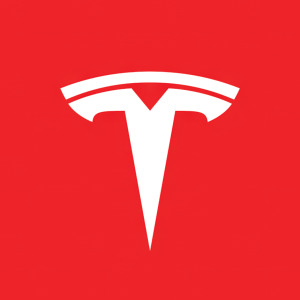Tesla Releases Second Quarter 2025 Financial Results
Rhea-AI Summary
Tesla (NASDAQ:TSLA) reported challenging Q2 2025 financial results, with total revenue declining 12% year-over-year to $22.5 billion. The company's GAAP net income fell 16% to $1.2 billion, with diluted EPS of $0.33.
Vehicle deliveries decreased 13% to 384,122 units, while production remained flat at 410,244 vehicles. Operating margin contracted to 4.1%, and free cash flow was $146 million. The company maintained a strong balance sheet with $36.8 billion in cash and investments.
Despite automotive headwinds, Tesla highlighted its strategic pivot toward AI and robotics, launching its first Robotaxi service in Austin and completing its first autonomous vehicle delivery. The company also confirmed plans for new vehicle launches, including a more affordable model in 2025 and the Cybercab in 2026.
Positive
- Launch of first Robotaxi service in Austin marks entry into AI-driven services
- Services and Other segment revenue grew 17% YoY to $3.0 billion
- Strong balance sheet with $36.8 billion in cash and investments
- Energy storage deployments increased 2% YoY to 9.6 GWh
- New affordable model and Cybercab production timeline confirmed
Negative
- Revenue declined 12% YoY to $22.5 billion
- Vehicle deliveries dropped 13% YoY to 384,122 units
- Operating margin contracted to 4.1%, down 219 basis points
- GAAP net income fell 16% YoY to $1.2 billion
- Vehicle inventory increased to 24 days of supply from 18 days YoY
News Market Reaction 39 Alerts
On the day this news was published, TSLA declined 8.20%, reflecting a notable negative market reaction. Argus tracked a trough of -5.9% from its starting point during tracking. Our momentum scanner triggered 39 alerts that day, indicating elevated trading interest and price volatility. This price movement removed approximately $95.68B from the company's valuation, bringing the market cap to $1.07T at that time.
Data tracked by StockTitan Argus on the day of publication.
Tesla's Revenue and Profits Decline as Company Highlights Pivot to AI and Robotics
Tesla, Inc. announced its financial results for the second quarter of 2025, revealing a year-over-year decline in revenue and profitability. The company reported total revenues of
The electric vehicle maker launched its first Robotaxi service in Austin, Texas, in June and emphasized significant investments in its autonomy and energy divisions. Net income attributable to common stockholders (GAAP) was
Financial Snapshot: Q2 2025
- Total Revenue:
$22.5 billion 12% - GAAP Net Income:
$1.2 billion 16% - GAAP Diluted EPS:
$0.33 18% - Non-GAAP Diluted EPS:
$0.40 23% - Operating Margin:
4.1% - Free Cash Flow:
$0.1 billion
Financial Performance Breakdown
According to the company's shareholder update, the
Tesla's profitability was also affected, with GAAP operating income falling
Free cash flow, a metric defined by the company as operating cash flow less capital expenditures, was
Operational Metrics and Production
Tesla produced a total of 410,244 vehicles in the second quarter, roughly flat compared to the same period in 2024. However, total vehicle deliveries fell by
The company's global vehicle inventory, measured in days of supply, increased to 24 days, up from 18 days in the second quarter of the previous year. In its energy division, Tesla deployed 9.6 GWh of energy storage products, a
Pivoting to AI and Autonomy
Tesla placed significant emphasis on its progress in artificial intelligence and autonomous vehicle technology. The company stated that the June launch of its Robotaxi service in Austin, while initially limited in scope, marks the beginning of its push into AI-related services. The company believes its camera-only approach, trained on data from its global fleet, will allow it to rapidly scale its autonomous network.
In another milestone, the company reported completing the "world's first autonomous delivery of a vehicle," where a new Model Y drove itself from the factory to its owner's home in Austin. To support these efforts, Tesla expanded its AI training compute power, bringing its total to the equivalent of 67,000 H100 GPUs.
Product Roadmap and Outlook
Looking ahead, Tesla stated that its plans for new vehicles launching in 2025 remain on track. This includes the initial production of a more affordable model in the first half of 2025, with volume production slated for the second half of the year.
The company also provided timelines for other future products, scheduling both the Tesla Semi and the purpose-built Robotaxi, known as the Cybercab, for volume production starting in 2026.
In its outlook, the company acknowledged a "sustained uncertain macroeconomic environment" due to shifting tariffs and fiscal policies. Tesla's focus remains on prudently growing vehicle volumes by utilizing its existing production capacity before building new lines. "While we continue to execute on innovations to reduce the cost of manufacturing and operations, over time, we expect our hardware-related profits to be accompanied by an acceleration of AI, software and fleet-based profits," the company said in its report.
This article is based solely on information provided in Tesla's Q2 2025 Update dated July 23, 2025. The content is for informational purposes only and does not constitute financial, investment, legal, or tax advice. Stock Titan and its writers make no representations as to the accuracy, completeness, or timeliness of the information. Investors should conduct their own due diligence before making any investment decisions.
Source: Tesla, Inc.







